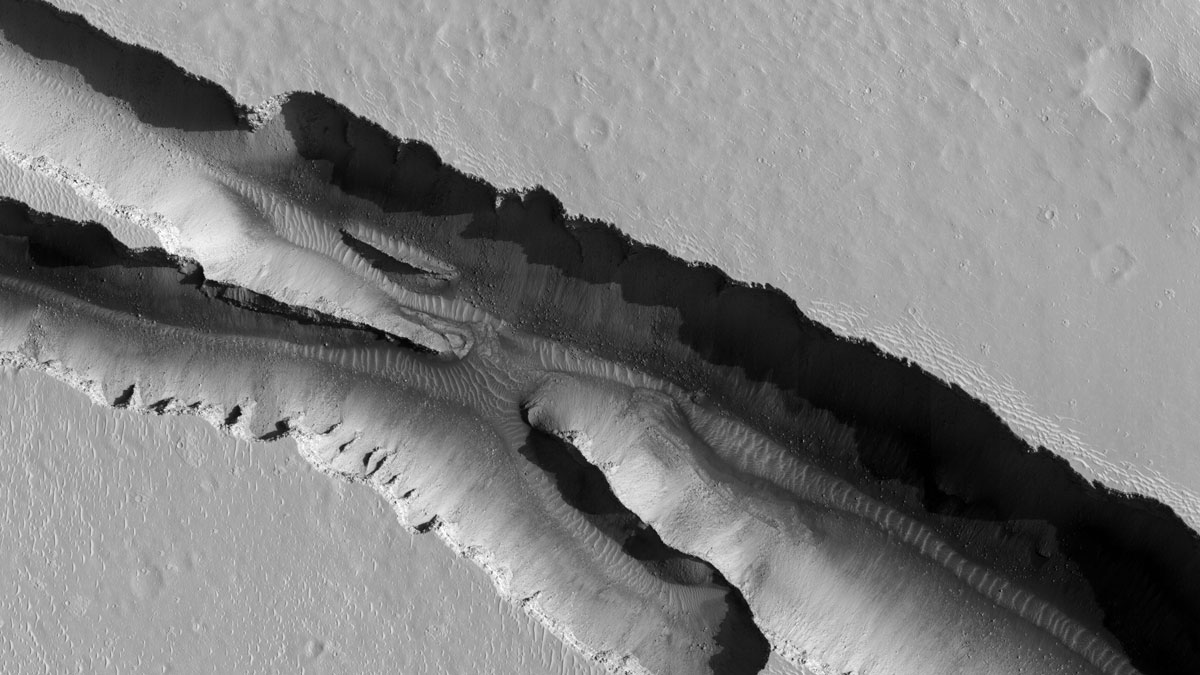A new analysis of seismic data of NASA’s InSight mission suggests that Mars could have an earthquake season. Researchers observed that certain kinds of marsquakes became more frequent beginning in the northern spring with a peak in the summer.
“We are really convinced that there is a season of seismic activity,” said Martin Knapmeyer of the German Aerospace Center, who was part of the multinational team that carried out the analysis. The seasonal changes they found are best explained by annual changes in carbon dioxide (CO2) ice load or illumination or by the annual solar tide. Tidal forcing by Mars’s moon Phobos—which had previously been hypothesized to drive marsquakes—could not explain the seasonal pattern in the data.
Seismicity in the Solar System
Seismic activity on Earth isn’t perfectly random, but it isn’t thought to vary with the seasons except for in certain places like Nepal, where heavy rains during the summer monsoon load rocks with water and make quakes less likely. Generally, earthquakes are assumed to be scattered mostly randomly through time, with the number of quakes above a certain magnitude expected to occur within a certain period given by a formula called the Gutenberg-Richter law. But other worlds play by different geological rules.
On the Moon, tremors mostly follow a monthly cycle. As it orbits Earth, the Moon experiences tidal forces thanks to Earth’s gravity. These tidal forces are thought to be a major driver of lunar seismicity, and data from lunar seismometers installed during the Apollo missions confirmed that moonquakes are driven by the tides.
The InSight team began to suspect there might be some seasonal or other time variation in the rate of high-frequency marsquakes, which are the most common type.
Before the Interior Exploration using Seismic Investigations, Geodesy and Heat Transport (InSight) lander touched down on Elysium Planitia in 2018, researchers mostly assumed that marsquakes would behave like earthquakes—that is, they would occur mostly randomly and follow the Gutenberg-Richter law. But by 2020, the InSight team began to suspect there might be some seasonal or other time variation in the rate of high-frequency marsquakes, which are the most common type.
“High-frequency events have just been part of the puzzle of what are we seeing on Mars,” said planetary geologist and InSight deputy principal investigator Suzanne Smrekar of the Jet Propulsion Laboratory, who was not involved in the newer study. “There have been a lot of hypotheses put forward within the team.”
Explaining a Summer of Marsquakes
To investigate possible drivers of seasonal seismicity, the researchers began by ruling out the possibility that the uptick in marsquake activity they saw during the summer reflected changes to the InSight instrument settings or seasonal changes in the amount of seismic noise caused by wind.
Confident that their signal was real, the researchers tested how well different marsquake-driving mechanisms could explain the data. Variations in marsquake activity didn’t follow Phobos’s orbit, meaning it is unlikely that the moon is driving the high-frequency marsquakes. Instead, the summertime burst in marsquake activity corresponded well to what scientists would have expected if seasonal tidal forces from the Sun or changes in the amount of CO2 ice loading were driving the quakes. The modeling results also noted that variation in sunlight through the year corresponded to variation in quakes, suggesting that seasonal variations in sunlight could contribute to the summer marsquake season, but the researchers don’t yet fully understand the relationship.
“All three [explanations] are feasible,” said Knapmeyer.
A Fluke Year?
The 520-day period Knapmeyer and his colleagues considered was only about 75% of a Martian year and lacked winter observations. However, high-frequency marsquakes had stopped occurring altogether by the Martian winter, so it wouldn’t have made a difference to have a full year of data, said Knapmeyer.
“It was clear that during the rest of this year there wouldn’t be any [high-frequency marsquake] detections anyway,” he said. “So one could call it a day, so to speak, and run the analysis.”
“We are really convinced that there is a seasonal variation in the seismic activity on Mars.”
The next step in studying the phenomenon, both Knapmeyer and Smrekar said, is to see whether future years of marsquake data correspond to the seasonality predictions put forward in this paper. “They’ve made a good case…but I wouldn’t say it’s 100% locked down that it is, in fact, seasonal,” said Smrekar. The study’s authors also acknowledged that it’s possible the marsquake burst observed was a fluke.
Knapmeyer said that efforts to look for seasonality over multiple years of InSight data are underway. “Currently, the second [seasonal] cycle is going on,” he said, and the new observations correspond well to what would be expected if marsquakes were, indeed, seasonal. “So we are really convinced that there is a seasonal variation in the seismic activity on Mars.”
—Elise Cutts (@elisecutts), Science Writer

